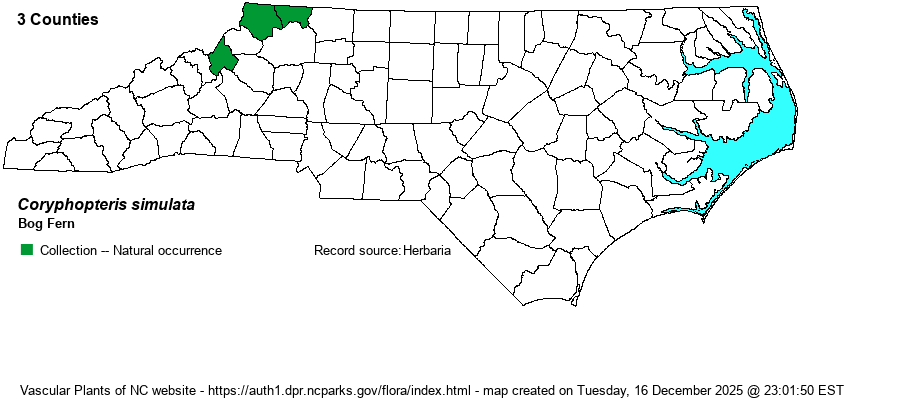| Author | (Davenport) S.E. Fawcett | |
| Distribution | S.E. Fawcett (2018) published this revised name in the American Fern Journal. In NC, the species is limited to the northern Mountain counties, collected so far in Alleghany, Ashe, and Avery counties.
This is a Northeastern species, ranging from N.S. south in the Appalachians to northern VA and WV, and somewhat disjunct to northwestern NC and adjacent TN. It also occurs at a few places in eastern VA. | |
| Abundance | Very rare, known apparently from single sites in each of three counties. It was first discovered in the state in 1984. This is a State Endangered species. | |
| Habitat | In NC, the species is restricted to bogs, called "acid peat bogs" by Weakley (2018). |
| Phenology | Fruits from July to September. | |
| Identification | This very rare (in NC) species is quite similar to Marsh Fern (Thelypteris palustris), even though Bog Fern has been moved out of that genus into a different genus. The stipe is often 6 inches long, and the blade is typically narrowly lanceolate (narrower toward the apex), about 1-1.5 feet long and 5-6 inches wide. The blade is pinnate-pinnatifid, such that each pinna has numerous pinnules but not quite separated to the midrib. There are 15-22 pairs of pinnae, sessile, about 2-3 inches long and 1/2-inch wide. The pinnules are mostly oblong and rounded at the tips. It has rounded sori under the pinnules. These characters essentially apply also to Marsh Fern, so you need to separate them by technical characters; Bog Fern has "Lateral veinlets of pinna lobes unbranched, or rarely forked; abaxial [lower] surface of blade with scattered silvery to golden resinous glands" (Wofford 1989); Marsh Fern has "Lateral veinlets of pinna lobes mostly forked; abaxial [lower] surface of the blade without glands" (Wofford 1989). New York Fern (Parathelypteris noveboracensis) has the blade strongly tapering at both the apex and the basal ends, whereas these other two species have the lower pinnae of the blade about as long as the several pinnae above them (i.e., the base of the blade is not tapered near the ground). | |
| Taxonomic Comments | The species was long named as Dryopteris simulata, but recent taxonomic work on this species indicated some evolutionary problems with it. The species has since gone through several additional names, including Parathelypteris simulata, and recently as Coryphopteris species 1. It is hoped that this fern will hereafter retain a consistent scientific name!
| |
| Other Common Name(s) | Massachusetts Fern | |
| State Rank | S1 | |
| Global Rank | G4G5 | |
| State Status | E | |
| US Status | | |
| USACE-agcp | | |
| USACE-emp | | |

